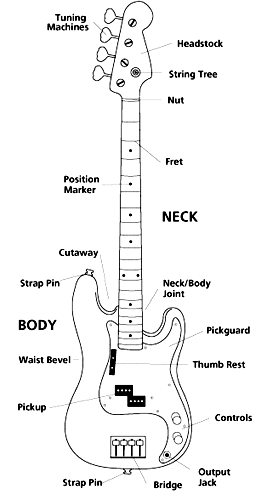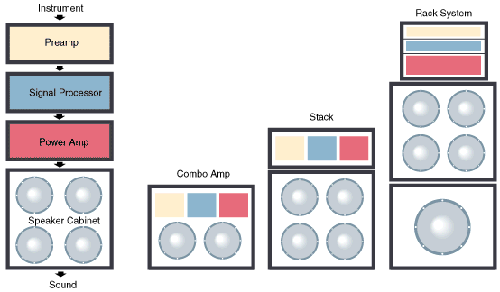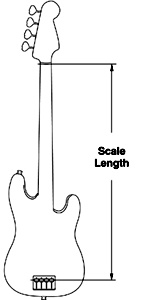Gear Glossary
 AC:
Alternating current; a form of electric current that oscillates
with a specific frequency. AC most commonly
refers to the current that comes from electrical outlets, but a
musical signal travelling through a cable is AC,
analogous (in amplitude and frequency) to the sound waves we
hear. Compare DC.
AC:
Alternating current; a form of electric current that oscillates
with a specific frequency. AC most commonly
refers to the current that comes from electrical outlets, but a
musical signal travelling through a cable is AC,
analogous (in amplitude and frequency) to the sound waves we
hear. Compare DC.
Active electronics: Amplification
circuitry built into an instrument, requiring a source of power
(usually a 9-volt battery). In an active pickup, the circuitry is
built into the pickup housing. Compare passive electronics.
Alnico: A combination of aluminum, nickel, and cobalt,
commonly used to make pickup magnets.
Analog circuit: A circuit that carries an AC signal whose waveform is analogous (in
frequency and amplitude) to the sound wave it represents. Compare
digital.
Balanced line: A signal cable or output jack that uses
3-pronged XLR connectors to reduce noise.
Two of the prongs carry signals that are identical but 180
degrees out of phase. At the end of the line, the reverse-phase
signal is brought back in phase and added to the other signal;
this cancels out noise picked up along the line, but doesn't
affect information that was in the line at the beginning.
Biamping: An amplification
method in which a signal is split into two signals (one
predominantly low frequencies and the other predominantly high
frequencies), each signal going to a separate power amplifier. A
bi-amped signal tends to sound clearer than a mono-amped signal.
Ceramic: A mixture of metal and a clay-based substance,
commonly used to make pickup magnets.
Chorus: A delay-based effect that simulates two or more
instruments playing in unison. See Gadgets & Gizmos,
July/Aug '93.
Combo amp: A preamp, power amp, and speaker cabinet in
a single unit.
 Compressor:
An effect that reduces dynamic range. A compressor often makes a
bass sound punchier by putting each note more or less at the same
volume. See Gadgets & Gizmos, July/Aug '93.
Compressor:
An effect that reduces dynamic range. A compressor often makes a
bass sound punchier by putting each note more or less at the same
volume. See Gadgets & Gizmos, July/Aug '93.
Crossover: A circuit that divides the audio spectrum
into two or more parts; these parts can be amplified separately
and sent to separate amplifiers or speaker systems. See biamping.
Cryogenic treatment: A process of slowly cooling
strings to extremely low temperatures, in order to increase
string longevity and reduce micro-irregularities in the metal.
dB: See decibel.
DC: Direct
current; a steady stream of electrons, such as the current
produced by a battery. Compare AC.
Decibel: A unit that expresses
amplitude, loudness, or intensity.
De-esser: A circuit designed to reduce excessive
sibilance ("s" sounds) when using a microphone.
Digital circuit: A circuit that converts a signal into
a number-based digital signal, performs mathematical calculations
on the digital signal (such as creating reverb effects), and
converts the signal back into a waveform-based analog signal.
Compare analog circuit.
Direct box: A device that takes the signal from your
bass and converts it to low-impedance balanced line, which can
then be sent to a recording console or PA mixer.
Driver: Another word for speaker: the sound-producing
unit (cone, voice coil, magnet, and frame) that is mounted in a
speaker cabinet or enclosure. Note: Sometimes the word
"speaker" is also used interchangably with
"cabinet" or "enclosure."
Dynamic range: The range of loudness, in decibels, that
an instrument, amp, or other device can handle. It's the
difference between the quietest possible signal (where the signal
and the "noise floor" are at the same level) and the
loudest (where significant distortion sets in).
Effects loop: A set of jacks that breaks the circuit of
a preamp or amplifier and lets you add a device (such as an
effect box) inside the signal chain of the unit. An effects loop
normally consists of a "send" jack, which outputs a
signal, and a "return" jack, which receives the signal
and thus completes the circuit.
Enclosure: See speaker cabinet.
Envelope follower: An effect that rolls off high
frequencies as the signal level decreases. The sound is similar
to that of a wah-wah pedal, since EQ sweeps follow the decay of
each note.
Equalizer: An effect, often built into amps, that lets
you boost or cut certain bands of the frequency spectrum, thus
changing the tone. See Gadgets & Gizmos, July/Aug '93.
Exciter: A circuit designed to make a signal sound more
clear, punchy, bright, or loud, without the use of ordinary EQ or
gain.
Expander: A circuit that increases dynamic range by
making the loudest notes louder and the softest notes softer.
Flanger: A delay-based effect that produces a
"whooshing" sound that sweeps across the frequency
spectrum. See Gadgets & Gizmos, July/Aug '93.
Flatwound strings: Strings made of a core wrapped with
a flat, ribbon-like winding material. Compared to roundwounds,
flatwounds produce less finger noise, but they tend to be
dull-sounding. See The Controversial World Of String Design.
Folded horn: A speaker cabinet design that reflects and
then projects sound into a room. On their own, folded horns
produce loud, deep bass, but not much highs--so they require
additional high-end drivers (sometimes built into the cabinet).
See Cabinet Basics 101.
Graphite: A form of carbon used in instrument
construction. Graphite fiber, when set into resin, has a high
stiffness-to-weight ratio and provides strength and stability to
bass necks.
Groundwound strings: Roundwound strings that have been
ground or burnished to reduce finger noise and fret wear. See The
Controversial World Of String Design.
Half-rack: A format for mounting equipment. Two
half-rack units mounted side by side take up one space in a
standard 19" rack.
Half-round strings: See groundwound strings.
Head: A preamp and power amp in a single unit.
Sometimes called a top or brain.
Hertz: A unit that expresses frequency; 1Hz is
equivalent to one waveform cycle per second.
Highpass filter: A component of a circuit that lets
high frequencies pass but cuts low frequencies.
Humbucking pickup: A pickup that cancels
electromagnetic noise (hum) by using two coils wired out of phase
and two magnets oriented with opposite polarities. See Selecting
A Pickup, April '95.
Hz: See hertz.
Impedance: The AC equivalent of DC resistance; impedance can be thought of as a
load on a signal. It's important to consider impedances when
connecting any two electronic devices, such as amp and speaker or
pickup and amp.
J pickup: A bright-sounding bar-shaped pickup
associated with the Fender Jazz Bass. J pickups usually have a
single coil, but some J's are double-coil humbuckers. See Selecting
A Pickup April '95.
Limiter: An effect that sets a maximum output level. If
a signal is limited, once the limiter's threshold level is
reached, increased input won't result in increased output. See Gadgets
& Gizmos, July/Aug '93.
Lowpass filter: A component of a circuit that lets low
frequencies pass but cuts high frequencies.
MIDI: Musical Instrument Digital Interface--the digital
language that MIDI-equipped devices use to communicate with one
another. Bassists can use MIDI to automate effect-program changes
or to drive synth modules with a MIDI bass controller.
MIDI controller: Any musical instrument that produces
MIDI signals.
Multi-tap delay: A delay that produces multiple
independent echoes rather than one echo.
Neck-through-body design: An instrument-building method
in which the neck passes all the way through the body, and the
body is actually two "wings" glued onto the side of the
neck block.
Noise gate: A circuit that reduces the output level
when no signal is coming through, thereby reducing noise and
increasing the signal-to-noise ratio.
Onboard: Built into an instrument.
Overdrive: A circuit that boosts signal and/or adds
distortion.
P pickup: A warm-sounding pickup (split into two
staggered halves) associated with the Fender Precision Bass. See Selecting
A Pickup, April '95.
Parametric EQ: An equalizer that lets you specify the
frequency band(s) it is affecting. See Gadgets & Gizmos,
July/Aug '93.
Passive electronics: A circuit that requires no
external power source. Compare active electronics.
Peak EQ: A type of EQ band with a frequency center that
can be cut or boosted, with reduced effect on surrounding
frequencies. Compare shelving EQ.
Phantom power: A feature of an amplifier, mixer, etc.,
that sends DC current to the active
electronics of a microphone, instrument, or other device.
Phaser: A delay-based effect that produces a liquid,
shimmering sound. See Gadgets & Gizmos, July/Aug '93.
 Phenolic: A synthetic resin commonly used in
fingerboards. Also called ebonol.
Phenolic: A synthetic resin commonly used in
fingerboards. Also called ebonol.
Pickup: A device that turns the mechanical energy of
string vibration into electrical energy (an AC
signal).
Piezoelectric pickup: A non-magnetic pickup, commonly
used in upright basses and acoustic bass guitars and occasionally
in electrics. The mineral-crystal substance in a piezoelectric
generates a voltage potential when vibrated or stressed.
Piezoelectrics, which have high impedances, need to be buffered
by an appropriate preamp in order to produce a good sound. See 10
Transducers for Acoustic Upright Bass, June '96.
PJ configuration: A pickup arrangement in which a P
pickup is near the neck and a J pickup is near the bridge.
Pot: Short for potentiometer, a variable resistor used
in tone and volume controls.
Preamp: An amplifier circuit that takes the signal from
an instrument (or in the case of an onboard preamp, a pickup or
set of pickups) and alters its impedance and/or amplitude,
thereby preparing the signal for a power amp. Preamps may also
include EQ sections, compressors, effects loops, etc. See Bass
Amp Basics, July '92.
Pre-post switch: A feature, sometimes found on preamps,
that lets you bypass the EQ section, giving you a
"pre-EQ" output signal.
Programmable: Capable of storing user-customized data,
such as EQ settings or effect configurations.
Quarter-round strings: See groundwound strings.
Rackmount: Designed to be installed in a standard
19"-wide equipment rack.
Rackmountable: Capable of being installed in a standard
19"-wide equipment rack, but designed to be used elsewhere
also (such as on a tabletop or floor).
Relief: The slight up-bow that a neck needs to avoid
fret buzz.
Reverb: An effect that simulates the sound of playing
in a room or hall. See Gadgets & Gizmos, July/Aug '93.
RMS: Root mean square.
"Watts RMS" is a unit that
expresses average power along a waveform, rather than at its
peaks and troughs. RMS values represent
true amplifier power output; figures that use terms such as
"peak power" can be deceptively large.
 Roundwound strings: Strings made of a core
wrapped with a round winding material. Roundwound strings are
bright but squeaky, and they tend to wear down frets and fretless
fingerboards. Compare flatwound and groundwound strings. See The
Controversial World Of String Design.
Roundwound strings: Strings made of a core
wrapped with a round winding material. Roundwound strings are
bright but squeaky, and they tend to wear down frets and fretless
fingerboards. Compare flatwound and groundwound strings. See The
Controversial World Of String Design.
Scale length: The distance from an instrument's nut to
its theoretical bridge position.
Sealed cabinet: A speaker cabinet without a vent (an
opening or hole); compare vented cabinet. Sealed cabinets can
handle large amounts of power and have excellent
"damping" (controlled cone movement), but aren't very
efficient. Sometimes called infinite baffle. See Cabinet
Basics 101.
Shelving EQ: A type of EQ band (usually the lowest or
highest one) which cuts or boosts all frequencies past a central
frequency, with reduced effect on frequencies toward the mid
bands. Compare peak EQ.
Shielding: The use of a grounded conductor surrounding
the circuitry of an instrument, the wires inside a cable, or
anything else that carries an electrical signal. Pickups,
instrument control cavities, and audio cables should all be
shielded to reduce electrostatic noise.
SMPTE: A protocol for highly precise and accurate
synchronization among audio devices such as sequencers and tape
machines, or between audio and video devices. (Stands for the
Society of Motion Picture and Television Engineers.)
Soapbar pickup: Generic term for any rectangular
humbucking pickup.
Soft-key control: The use of several buttons underneath
an LCD display; the function of each button is shown by the
display. Depending on the mode of the unit, the LCD can give
several functions for each key, thus giving access to many
parameters with just a few front-panel controls.
Solid-state circuitry: Circuitry using transistors
instead of vacuum tubes to amplify signals. Compare tube.
Speaker cabinet: A unit that contains one or more
drivers; speaker cabinets are often built to control and optimize
the sound of the driver(s). Also called an enclosure or speaker
system. See Cabinet Basics 101.
Speaker cabinet configuration: A figure that describes
the size and number of drivers in a cabinet. A 1x15 cabinet
contains a single 15" driver, a 4x10 contains four 10s, etc.
Subwoofer: A cabinet designed to handle very low
frequencies.
True diversity: A wireless-system design in which two
receivers add their signals to reduce drop-outs and other
undesirable effects.
Truss rod: A rod inside an instrument neck that, when
properly adjusted, counteracts the tendency for string tension to
bow the neck.
Tube: An amplifier component made of glass, often used
in instrument amps. Also called a vacuum tube or valve. Many
players prefer the "tube sound" over the sound of
solid-state amps, though tube amps tend to be larger, heavier,
and more fragile than solid-state amps.
Tweeter: A small driver designed to handle high
frequencies.
Vented cabinet: A speaker cabinet with a
"port" (hole) in one of its walls. Vented cabinets are
more efficient than sealed cabinets, but the speakers blow more
easily. Also called ported cabinet. Compare sealed cabinet, and
See Cabinet Basics 101.
 Wah-wah pedal: An effect that adds a narrow
boost sweepable across the frequency spectrum, often producing a
"talking" or "quacking" sound.
Wah-wah pedal: An effect that adds a narrow
boost sweepable across the frequency spectrum, often producing a
"talking" or "quacking" sound.
Woofer: A large driver designed to handle low
frequencies.
XLR jack: A 3-pronged jack
commonly used with microphones and other balanced lines. See
balanced line.
 AC:
Alternating current; a form of electric current that oscillates
with a specific frequency. AC most commonly
refers to the current that comes from electrical outlets, but a
musical signal travelling through a cable is AC,
analogous (in amplitude and frequency) to the sound waves we
hear. Compare DC.
AC:
Alternating current; a form of electric current that oscillates
with a specific frequency. AC most commonly
refers to the current that comes from electrical outlets, but a
musical signal travelling through a cable is AC,
analogous (in amplitude and frequency) to the sound waves we
hear. Compare DC. 
 Phenolic: A synthetic resin commonly used in
fingerboards. Also called ebonol.
Phenolic: A synthetic resin commonly used in
fingerboards. Also called ebonol.  Roundwound strings: Strings made of a core
wrapped with a round winding material. Roundwound strings are
bright but squeaky, and they tend to wear down frets and fretless
fingerboards. Compare flatwound and groundwound strings. See The
Controversial World Of String Design.
Roundwound strings: Strings made of a core
wrapped with a round winding material. Roundwound strings are
bright but squeaky, and they tend to wear down frets and fretless
fingerboards. Compare flatwound and groundwound strings. See The
Controversial World Of String Design.  Wah-wah pedal: An effect that adds a narrow
boost sweepable across the frequency spectrum, often producing a
"talking" or "quacking" sound.
Wah-wah pedal: An effect that adds a narrow
boost sweepable across the frequency spectrum, often producing a
"talking" or "quacking" sound.